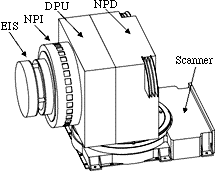ASPERA-3 - Ion, electron and neutral particle detector package
ASPERA-3 is an advanced and compact ion, electron and neutral particle detector package developed for the MarsExpress mission to investigate the plasma and neutral particle environment near Mars. ASPERA-3 will perform the first ever Energetic Neutral Atom (ENA) measurements at another planet in the low energy range (100 eV - 10 keV).


Science objectives
The general scientific objective of ASPERA-3 is to study the solar wind - atmosphere interaction and to characterize the plasma and neutral gas environment in the near-Mars space through ![]() Energetic Neutral Atom (ENA) Imaging and in-situ plasma measurements. ENA imaging is a novel technique to visualize and monitor processes in dilute gases. ENAs are produced via charge exchange processes between singly-charged ions and neutral gases of the exosphere / upper atmosphere. Due to their neutrality, ENAs are decoupled from the electromagnetic fields and propagate on straight paths like photons. Directional detection of the ENAs therefore yields a global image of the interaction region.
Energetic Neutral Atom (ENA) Imaging and in-situ plasma measurements. ENA imaging is a novel technique to visualize and monitor processes in dilute gases. ENAs are produced via charge exchange processes between singly-charged ions and neutral gases of the exosphere / upper atmosphere. Due to their neutrality, ENAs are decoupled from the electromagnetic fields and propagate on straight paths like photons. Directional detection of the ENAs therefore yields a global image of the interaction region.
The specific objectives are:
- The determination of the instantaneous global distributions of plasma and neutral gas near Mars
- The study of plasma induced atmospheric escape
- The investigation of atmospheric modifications through ion bombardment
- The investigation of the energy deposition from the solar wind to the ionosphere
The studies to be performed address the fundamental question: How strongly do the interplanetary plasma and electromagnetic fields affect the Martian atmosphere? This question is directly related to the problem of Martian dehydration. Where is the water? Is it lost or frozen? If it is the former, what could produce such an effective escape mechanism? If it is the latter, where is the tremendous amount of water stored? Since liquid water is the fundamental requirement for life, a clear understanding of the fate of the Martian water is a crucial issue in resolving the problem whether or not life existed on Mars in the past. No instruments with similar scientific objectives and capabilities have been or are planned to be flown to Mars.
Instrument description
ASPERA-3 comprises four sensors:

 NPI (Neutral Particle Imager)
NPI (Neutral Particle Imager)
measures the integral energetic neutral atoms flux with no mass and energy resolution but high angular resolution. NPD (Neutral Particle Detector)
NPD (Neutral Particle Detector)
resolves mass (hydrogen and oxygen) and velocity (energy range 0.1 - 10 keV) of the ENA.- EIS (Electron and Ion Spectrometer)
determines the electron and ion distribution to energies up to 40 keV - IMA (Mass resolving Ion Analyser)
measures the main ion components (H+, H2+, He+, O+), molecular ions from 20 to 80 amu/q and up to 106 amu/q for dusty plasmas in an energy range from 100 eV to 40 keV/q.
To increase angular coverage NPI, NPD, and EIS are mounted on a scanning platform.

ASPERA-3 performance
| NPI | NPD | IMA | EIS | |
|---|---|---|---|---|
| Particles | ENA | ENA | ions | electrons |
| Energy, keV | 0.1 - 60 | 0.1 - 10 | 0.01 - 40 | 0.001 - 20 |
| Energy res. dE/E | - | 80% | 10% | 7% |
| Mass res. | - | H, O | M/dM = 5 | - |
| FoV | 9° x 344° | 9° x 180° | 4.6° x 360° | 10° x 360° |
| Angular Res. (FWHM) | 4.6° x 11.5° | 5° x 30° | 5° x 22.5° | 5° x 22.5° |
| G-Factor/pixel, cm2 sr | 2.5 x 10-3 | 6.2 x 10-3 | 3.5 x 10-4 | 3 x 10-4 |
| Efficiency, % | 1 | 1 - 25 | n/a | n/a |
| Time res. for full 3D, s | 32 | 32 | 32 | 32 |














